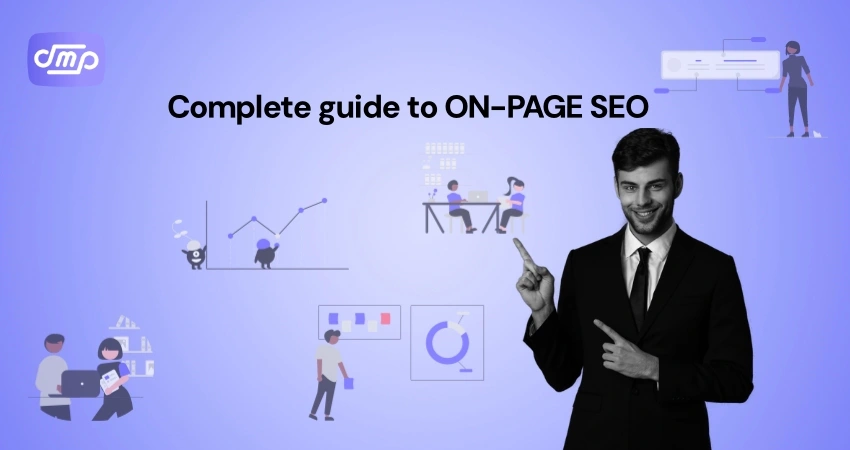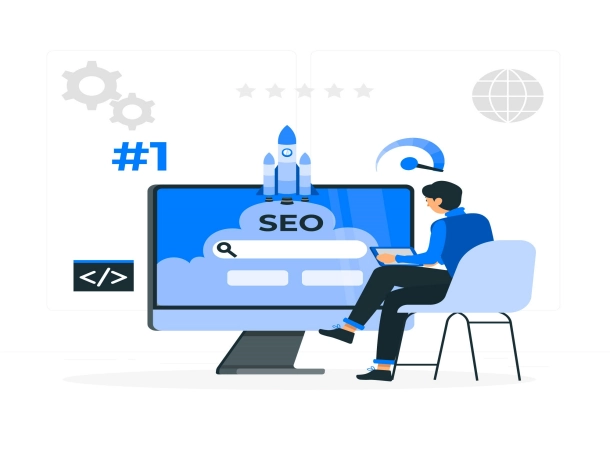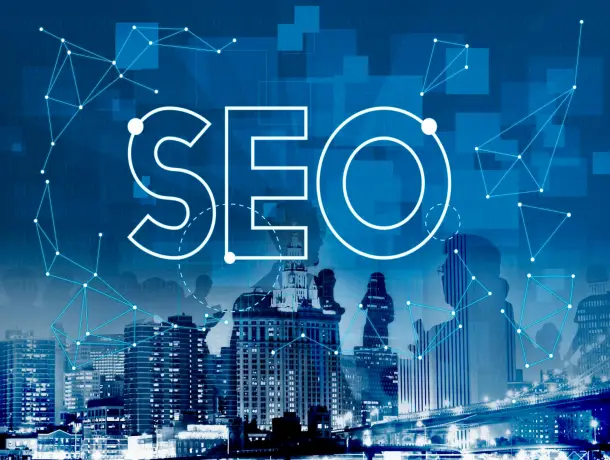
On-page SEO is the process of improving a webpage that will result in better ranking in search engine results and attract more relevant traffic. This guide to on-page SEO details on improving the web page’s content, meta tags, graphics and other components to make it user and search-engine friendly.
Elements of On-page SEO

- Using pertinent keywords in the content, meta tags, headings, and URLs is known as keyword optimisation.
- Producing valuable, high-quality content that users will find interesting.
- Including meta descriptions, titles, and keywords that fully capture the content of the page.
- Designing clear, readable URLs with pertinent keywords.
- Connecting important pages on your own website internally can enhance user experience and site structure.
- Adding pertinent filenames, alt tags, and captions to images.
Guide to on-page SEO

- On-page SEO optimization makes it simpler for websites to rank higher in search results by aiding search engines in understanding the content and relevancy of a website’s pages. As a result, the website receives more natural traffic and visibility.
- On-page features including headlines, internal links, and graphics can be optimised to enhance the website’s user experience. More engagement, fewer bounces, and improved conversion rates may result from this.
- Targeted keywords and phrases in on-page SEO will result in increased traffic to the website that is more likely to convert into leads and customers.
- Improving the on-page SEO on your website will get an edge over other websites in the same area or business.
- Long-term impact on-page SEO is inexpensive compared to other marketing strategies. Without investing a lot of money in advertising or other marketing initiatives, a website can continue to bring in organic traffic and keep its search engine rankings.
What are the ranking factors for on-page SEO?
A variety of on-page SEO ranking elements are evaluated by search engines. Some of the significant on-page elements include
Content quality: Original, high-quality content that benefits users is valued by search engines. The user experience, engagement, and search engine rankings of a website can all be strongly impacted by the quality of the content, making it a key component of on-page optimization. For the target audience, quality material must be educational, compelling, pertinent, and simple to read. Instead of writing material for search engines, you should write for your intended audience.
Ensure that it is pertinent, educational, and interesting for your audience, incorporate relevant keywords, use headers and subheadings and organize your writing. Make sure your information is readable by using brief paragraphs, bullet points, and straightforward language.
Optimization for keywords: Sites should be optimized for pertinent keywords in the content, meta descriptions, headings, and URL. it is very important not to stuff keywords into your content. Keyword stuffing will decrease your ranking on search engine ranking pages. Identify suitable keywords and phrases that your target audience is searching for by using keyword research tools.
Use these keywords in the page title, headings, subheadings, body copy, and meta descriptions as well as throughout your content. Create meaningful, keyword-rich page titles that accurately represent your page’s content to make them relevant. To guarantee that your page names are completely displayed on search engine results pages, keep them to no more than 60 characters.
Page titles: One of the most significant on-page ranking variables is the page title. Make your page title more intriguing and make it stick out in search results by adding modifiers like “best,” “top,” “new,” or “review.” To ensure that it appears completely on search engine result pages, keep your page title brief and under 70 characters, including spaces (SERPs).
You may increase the relevancy and visibility of your content in search results by incorporating relevant keywords, keeping it brief, using distinct titles for each page, and including your brand name. This can have a good effect on your website’s search engine rankings and click-through rates.
Meta descriptions: A well-written meta description can increase readers’ comprehension of the content of a page and increase click-through rates from search engine results pages (SERPs). Create keyword-rich meta descriptions that offer a succinct synopsis of the information on your page. For complete visibility in search engine results pages, keep your meta descriptions to 155 characters or less.
Header tags: Using header tags (H1, H2, H3, etc.) can assist in organising the page’s information and make it easier to read. Headings and subheadings will stand out be organized and draw attention to your content. Employ enough to lead visitors down the page in your text. Header tags play a crucial role in on-page optimisation because they provide your content structure and hierarchy, which makes it simpler for users and search engines to identify the primary subjects and subtopics addressed on a page. The following advice will help you make the most of header tags for on-page optimisation:
- The major keyword or phrase you wish to target should be included in the H1 tag for the page’s main title.
- Use the H2 and H3 heading tags for major and minor subheadings, respectively. To give context and increase the relevance of your material, be sure to add pertinent keywords in your subheadings.
- Utilize header tags in numerical order, starting with H1 for the main title, H2 for significant subheadings, and H3 for less significant subheadings.
- Too many header tags on a page might make your content appear cluttered and befuddle both users and search engines. Employ header tags only when they make sense and to give your content structure and hierarchy.
Image optimisation: Adding pictures, videos, and infographics to your page does more than just make it more appealing to the eye. Also, it offers you chances to improve your SEO. Pictures should be made search engine friendly by incorporating descriptive file names, captions, and alt text. Employ relevant keywords in your image alt tags to describe the image and increase its discoverability by search engines.
Internal linking: Internal linking can assist search engines in better grasping the content and hierarchy of your website by directing visitors to other pertinent sites inside it. Make sure your anchor text is evocative and pertinent to the linked page’s content. This makes the context of the link easier to interpret for both people and search engines. Links from pages with high authority, such as your homepage or top-level category pages, can help other pages on your website gain credibility and relevance. Review and update your internal links frequently to make sure they’re still current and relevant.
Mobile responsiveness: Having a website that is mobile-friendly is crucial because the bulk of internet traffic now comes from mobile devices. Mobile responsiveness refers to the website’s ability to adapt to various mobile devices and screen sizes including smartphones and tablets.
A website’s design and content will adapt to fit the smaller screen sizes of mobile devices when it is mobile responsive, making it simpler for visitors to browse and understand the material. This is crucial because Google gives significant priority to websites that offer a positive user experience, and a website that is not mobile-responsive may face high bounce rates and receive poor search engine ranks.
Page speed: Page speed plays a crucial role in website ranking. Page speed can be increased by optimising images, decreasing server response time, and utilising a content delivery network (CDN).
Reduce the number of items on your page, such as photos, videos, and scripts. Image optimisation and the use of a content delivery network can accomplish this. Cut down on server response time by selecting a reputable host and optimizing your server setup. Employ a content delivery network (CDN) to distribute your content from servers closer to your users’ computers. This can speed up page load times. Utilize a fast website builder with built-in page performance optimization tools, like WordPress or Squarespace.
On-page SEO checklist

Some of the important on-page SEO checklists include
- Performing keyword research: Find and target relevant keywords, and include them in your title tag, meta description, headers, and body content. Make sure your title tag is unique, descriptive, and contains your target keyword to properly optimise it.
- Optimise your meta description: Improve your meta description by writing one that entices readers to click through to your website and contains your target keyword.
- Using header tags: Use header tags to break up your content and make it easier to read (H1, H2, H3, etc.). Utilize these header tags to include your target keywords.
- Quality content: Produce excellent, informative content that is pertinent to your audience. Throughout your content, naturally, incorporate your target keywords.
- Image optimisation: Include relevant images and make your images more optimised by giving them descriptive file names and alt tags.
- Interlinking: Link to other pertinent pages on your website internally to help search engines understand the hierarchy of your content and the organization of your site.
- Mobile-friendly website: Make sure your website is mobile-friendly, as both users and search engines are increasingly valuing this.
- Use schema markup: To give search engines more details about your content, such as reviews, ratings, and events, use schema markup.
- Boost page speed: Reduce the amount of code on your website, compress images, and use caching to speed up page load times.
The guide to on-page SEO details the important elements of SEO. Keep in mind that on-page SEO is only one component of search engine optimisation; for optimal results, combine it with off-page SEO strategies like link building, social media marketing, and local SEO.
How to optimise your content for conversions?
Optimising a website for conversions will provide a user experience that motivates users to do a purchase, complete a form or sign up for a newsletter. These conversions will set an objective on what your website visitors want to accomplish and concentrate on developing the site to promote such behaviours. Some of the additional factors like simplifying the look and navigation of your website will result in achieving your conversion objectives. Use prominent CTAs that are clear and appealing to inspire visitors to take action on your website.
Conclusion
You can raise your website’s exposure in search engine results, attract more visitors, and eventually improve your chances of turning those visitors into leads and customers by optimising your website for on-page SEO considerations. Because it makes it simpler for search engines to rank your pages for pertinent keywords, on-page SEO is crucial because it aids them in comprehending the content and purpose of your website.
this guide to on-page SEO helps to understand that on-page SEO is a crucial component of website optimisation that may assist a website draw in more visits, enhancing user experience, and raising the likelihood that visitors will become paying customers. A website may increase its visibility and rating in search engine results pages, draw more organic traffic, and ultimately increase its chances of turning that traffic into leads and customers by optimizing these on-page ranking variables.












